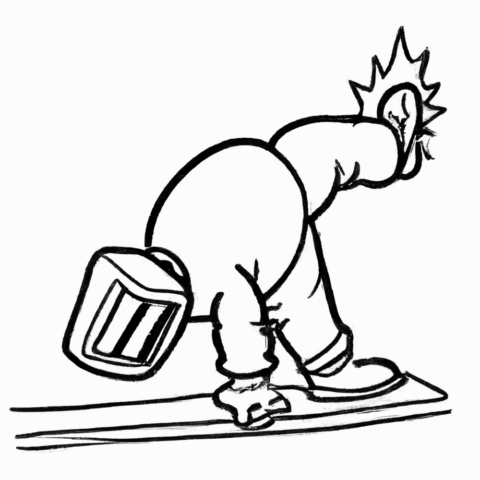In this guide:
Welding is a complex and technical process that requires knowledge, skill, and experience. One crucial aspect of welding that affects the quality and efficiency of the process is the welding position. Welding position refers to the orientation of the welding joint in relation to the welder’s body and the direction of the welding. Understanding welding positions is essential for welders of all skill levels to ensure they produce high-quality, defect-free welds.
In this article, we will provide an overview of welding positions, their importance, and the different types of welding positions used in various welding applications. We will also discuss the factors to consider when choosing the appropriate welding position for a specific welding project.
By the end of this article, you will have a better understanding of the importance of welding positions and the factors to consider when selecting the appropriate welding position for a particular welding project.
When it comes to welding, the position of the joint being welded can have a significant impact on the quality and integrity of the weld. Welding positions refer to the specific orientation of the joint and the direction of the welding arc. There are four primary welding positions: flat, horizontal, vertical, and overhead.
Understanding welding positions is essential for achieving high-quality welds. Welding in the correct position can help ensure that the weld penetrates the joint properly, and the weld metal is distributed evenly. Welding in the wrong position can result in weak, incomplete, or irregular welds, compromising the strength and durability of the finished product.
Types of Welding Positions
Flat position: The flat position is the easiest welding position and is characterized by welding on a horizontal surface. It is commonly used for fillet welds and lap joints. In the flat position, gravity helps keep the weld pool in place, making it easier to control the weld.
Horizontal position: The horizontal position is welding along the joint in a horizontal direction. It is commonly used for welding pipes and plates that are placed horizontally. In this position, the weld pool tends to sag due to gravity, making it more challenging to maintain the correct width and depth of the weld.
Vertical position: The vertical position involves welding on the vertical surface of the joint. It is used for welding pipes or plates that are in a vertical position, such as a wall or column. In this position, the weld pool tends to flow downwards due to gravity, making it essential to control the size of the weld pool to prevent excessive sagging or undercutting.
Overhead position: The overhead position is welding on the underside of the joint, and it is the most challenging welding position. It is typically used for welding structures that are positioned overhead or in hard-to-reach areas. In this position, the weld pool tends to drip downwards, making it challenging to control the weld size and penetration.
Understanding the different welding positions and their specific challenges is crucial for selecting the right welding technique and equipment for the job. In the next section, we will discuss some of the factors to consider when choosing the appropriate welding position.
Factors Affecting Welding Position Selection
The welding position can have a significant impact on the quality of the weld, and it is crucial to consider several factors when choosing the appropriate welding position.
Welding process
The welding process used can determine the welding position to be used. For example, TIG welding is commonly used in the flat position, while MIG and stick welding can be used in all positions.
Joint configuration
The joint configuration can also affect the welding position selection. For instance, if the joint is horizontal or vertical, the corresponding welding position is ideal.
Thickness of base material
The thickness of the base material is also a critical factor in the selection of the welding position. The thicker the base material, the more difficult it becomes to weld in a vertical or overhead position.
Welding position certification
Some welding positions require certification before the welder can perform welding in that position. For example, welding in an overhead position requires certification.
Welder’s skill level
The welder’s skill level is also an essential factor in selecting the welding position. A novice welder may struggle to perform a weld in a vertical or overhead position, whereas an experienced welder may find it easier.
Access to the joint
Access to the joint can also influence the selection of the welding position. If the joint is in a difficult-to-reach area, it may be necessary to use a specific welding position that provides better access.
Welding position specifications in the welding procedure specification (WPS)
The WPS specifies the welding position required for each joint. Welders must follow these specifications to ensure that the weld meets the required standards.
By considering these factors, welders can choose the most suitable welding position that will ensure high-quality welds and meet the welding specifications.
Selecting the Appropriate Welding Position
Analysing the welding joint and requirements
Before selecting a welding position, it is important to analyse the welding joint and determine the requirements of the final product. The joint’s size, shape, and thickness can determine which welding positions are possible. Additionally, the location of the joint and surrounding structures can impact the accessibility of certain welding positions.
Evaluating the factors affecting the welding position
Several factors can affect the welding position, including the material being welded, the welding process being used, and the skill level of the welder. The material’s properties, such as its thickness and strength, can determine the welding positions that are possible. Certain welding processes, such as gas tungsten arc welding (GTAW), may be better suited for certain positions than others. The welder’s skill level can also play a role, as some positions may be more challenging than others.
Determining the appropriate welding position
Once the joint has been analysed, and the factors affecting the welding position have been evaluated, the appropriate welding position can be determined. The chosen welding position should provide the best accessibility, deposition rate, and weld quality for the joint.
Adjusting the welding position to optimize weld quality
Even after selecting the appropriate welding position, adjustments may need to be made to optimize the weld quality. For example, the welding speed, travel angle, and electrode angle may need to be adjusted to achieve the desired penetration, bead shape, and fusion.
Tips and Techniques for Each Welding Position
Different welding positions require different techniques to achieve quality welds. We’ve provided a few tips and techniques for achieving high-quality welds in each position.
Flat Position
The flat position is the easiest and most common welding position. In this position, the welding is done horizontally along a flat surface. To achieve a quality weld in the flat position, the following techniques are recommended:
- Maintain a consistent travel speed to ensure even penetration and bead shape.
- Use a short arc length and a slight weave pattern to prevent undercutting.
- Angle the electrode slightly towards the direction of travel to ensure proper fusion.
Horizontal Position
The horizontal position is used when welding joints that are horizontal, such as the top of a beam. To achieve a quality weld in the horizontal position, the following techniques are recommended:
- Use a slightly larger electrode than in the flat position to increase deposition rates.
- Angle the electrode slightly uphill to ensure proper penetration.
- Maintain a consistent travel speed to ensure even penetration and bead shape.
Vertical Position
The vertical position is used when welding joints that are vertical or nearly vertical, such as the side of a beam. To achieve a quality weld in the vertical position, the following techniques are recommended:
- Use a smaller diameter electrode to help control the amount of heat input.
- Use a whip and pause technique to ensure even penetration and bead shape.
- Weld from the bottom up to prevent slag and weld metal from falling onto the weld.
Overhead Position
The overhead position is the most challenging welding position, as gravity can cause the weld metal and slag to fall out of the joint. To achieve a quality weld in the overhead position, the following techniques are recommended:
- Use a smaller diameter electrode to help control the amount of heat input.
- Use a whip and pause technique to ensure even penetration and bead shape.
- Weld from the top down to prevent slag and weld metal from falling onto the weld.
- Use a backing plate to support the weld and prevent burn-through.
Tips for Achieving Quality Welds in Each Position
In addition to the specific techniques for each welding position, the following tips can help achieve quality welds in any position:
- Clean the joint thoroughly to remove any dirt, oil, or other contaminants.
- Choose the appropriate welding process and filler metal for the material being welded.
- Follow the manufacturer’s recommendations for the welding parameters, such as voltage, amperage, and travel speed.
- Maintain a consistent arc length and electrode angle to ensure proper fusion.
- Practice proper safety procedures, such as wearing appropriate PPE and ensuring proper ventilation.
In conclusion, each welding position requires different techniques to achieve quality welds. By following the tips outlined in this article, welders can ensure that they are using the appropriate techniques for each welding position and achieving high-quality welds. Additionally, practicing good safety procedures is critical to preventing accidents and injuries in the welding process.
Common Welding Position Defects
Welding positions can greatly impact the quality of the weld, and various factors can lead to defects. By understanding the causes of these defects and following the appropriate tips, welders can prevent these issues and ensure high-quality welds.
Flat Position Defects
- Undercut: This defect is a groove or depression formed at the base of the weld. It is typically caused by excessive heat input or a high welding speed.
- Porosity: Porosity is caused by trapped gas pockets in the weld, and it weakens the joint. The main causes of porosity include improper shielding gas, contaminated base material, or incorrect welding parameters.
- Overlap: This defect occurs when the weld metal overlaps onto the base material. It can be caused by an incorrect welding technique or too high of a welding speed.
Tips for achieving quality welds in the flat position:
- Maintain a consistent arc length
- Use proper welding techniques
- Ensure adequate shielding gas coverage
- Avoid excessive heat input
Horizontal Position Defects
- Burn-through: Burn-through is a defect caused by excessive heat input, leading to the material melting through the weld. It can also be caused by improper fit-up or welding technique.
- Lack of penetration: Lack of penetration is a defect where the weld does not penetrate the full thickness of the material. It can be caused by incorrect welding parameters or poor fit-up.
- Slag inclusion: Slag inclusion is caused by the presence of slag in the weld. It can be caused by inadequate cleaning or shielding gas coverage.
Tips for achieving quality welds in the horizontal position:
- Use proper welding technique
- Avoid excessive heat input
- Ensure proper fit-up
- Clean the base material thoroughly
Vertical Position Defects
- Underfill: Underfill is a defect caused by inadequate weld metal deposition. It can be caused by improper welding technique or too low of a welding speed.
- Incomplete fusion: Incomplete fusion is a defect where the weld metal does not fully fuse to the base material. It can be caused by inadequate heat input or incorrect welding parameters.
- Cold lap: Cold lap is caused by incomplete fusion at the weld’s starting point. It can be caused by improper welding technique or too low of a welding speed.
Tips for achieving quality welds in the vertical position:
- Use proper welding technique
- Maintain a consistent travel speed
- Ensure proper heat input
- Clean the base material thoroughly
Overhead Position Defects
- Sagging: Sagging is a defect where the weld metal sags or drips down from the joint. It can be caused by excessive heat input or incorrect welding technique.
- Porosity: Porosity is caused by trapped gas pockets in the weld, and it weakens the joint. The main causes of porosity include improper shielding gas, contaminated base material, or incorrect welding parameters.
- Incomplete fusion: Incomplete fusion is a defect where the weld metal does not fully fuse to the base material. It can be caused by inadequate heat input or incorrect welding parameters.
Tips for achieving quality welds in the overhead position:
- Use proper welding technique
- Use a lower amperage setting
- Control the arc length carefully
- Ensure adequate shielding gas coverage
Safety Considerations for Welding Positions
Welding can pose safety hazards, and it is crucial to take the necessary safety measures to prevent injury and protect equipment. Each welding position has its unique safety hazards that welders must be aware of. Welders must wear appropriate PPE, secure their workpiece, and ensure that their work area is well-ventilated. By following these safety measures, welders can work safely and confidently in any welding position.
Flat Position Safety Risks
The flat position is the easiest welding position to work with and has the fewest safety hazards. However, welders must still wear appropriate personal protective equipment (PPE), including welding helmets, safety glasses, and gloves. They should also ensure that their work area is well-ventilated to prevent inhaling harmful fumes and gases.
Horizontal Position Safety Risks
Welding in the horizontal position poses some safety hazards. Welders should avoid working above their heads, as this can cause neck strain and fatigue. Welders should also secure their workpiece to prevent it from slipping or falling during welding, which can cause injury or damage to equipment. The use of a welding positioner can make welding in the horizontal position easier and safer.
Vertical Position Safety Risks
Welding in the vertical position is more challenging and can be more dangerous than welding in the flat or horizontal position. Welders must secure their workpiece to prevent it from slipping or falling during welding, which can cause injury or damage to equipment. Welders should also take extra care when welding overhead, as this can cause neck strain and fatigue. Adequate lighting is crucial when welding in the vertical position to ensure that welders can see the weld pool clearly.
Overhead Position Safety Risks
Welding in the overhead position is the most challenging and hazardous welding position. Welders should avoid working directly above their heads, as this can cause neck strain and fatigue. They should also use appropriate PPE, such as a welding helmet, to protect themselves from falling debris and harmful fumes and gases. Welders should secure their workpiece to prevent it from slipping or falling during welding, which can cause injury or damage to equipment.
In addition to these specific safety hazards, there are also general safety measures that welders should take when working in any welding position. These measures include:
- Ensuring that the work area is well-ventilated
- Keeping the work area clean and free of clutter
- Wearing appropriate PPE, including welding helmets, safety glasses, gloves, and clothing
- Using welding curtains or screens to protect nearby workers from harmful radiation and debris
- Keeping a fire extinguisher nearby in case of an emergency
- Inspecting welding equipment regularly and repairing or replacing any damaged parts
- Following all safety guidelines and regulations provided by the employer and the welding process manufacturer.
Understanding the importance of welding positions is critical to producing quality welds. Welding positions are determined by several factors, including joint configuration, welding process, and material thickness. By analysing these factors, welders can choose the appropriate welding position that will ensure high-quality welds and meet the welding specifications.
To achieve quality welds, welders must also understand the techniques required for each welding position. Additionally, it is essential to be aware of common defects that may arise when welding in each position and the safety hazards associated with each position.
In conclusion, selecting the appropriate welding position is crucial to producing quality welds and meeting welding specifications. By analysing the joint and evaluating the factors that affect welding positions, welders can choose the most suitable position. Adhering to safety measures and following the techniques required for each position can further improve the quality of the weld. As a final tip, always refer to the welding procedure specification (WPS) for specific guidance on welding positions for each project.




